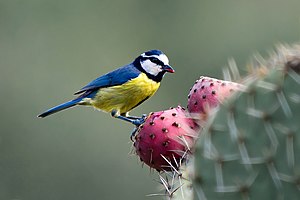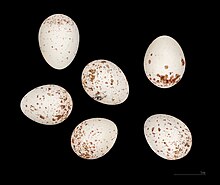Canary tit
| Canary tit | ||||||||||||
|---|---|---|---|---|---|---|---|---|---|---|---|---|

Canary tit ( Cyanistes teneriffae ) |
||||||||||||
| Systematics | ||||||||||||
|
||||||||||||
| Scientific name | ||||||||||||
| Cyanistes teneriffae | ||||||||||||
| ( Lesson , 1831) |
The Canary Tit ( Cyanistes teneriffae ) is a bird of the family tit (Paridae) that is found in cool, temperate forests of the Canary Islands and northwestern Africa. The Canary Tit and the Blue Tit were previously grouped together to form the same species.
Appearance and characteristics
The Canary Tit is about 12 cm long and weighs an average of 10 g. The forehead and the stripes above the eyes are white and frame a deep blue headstock. The reins and eye stripes are blackish and connected over the blue-gray neck, together with a black chin and collar they delimit the white cheeks and ear covers. The dorsal and rump plumage and the wing covers are blue-gray. Wing and tail feathers are gray with blue outside flags. The underside of the body is dark yellow with a black vertical stripe on the stomach. The under tail-coverts are greenish yellow, the under wing coverts yellow. The iris is dark brown to black, the small, pointed bill slate gray to black with paler cutting edges. The legs are dark gray. There is no sexual dimorphism in adult animals . In young animals, the over-eye stripes, neck and ear covers are yellow, the head plate and top of the body are greenish-blue to olive-green, the underside of the body is dull yellow, sometimes grayish or brown, and the black belly stripe is usually missing.
The subspecies palmensis is more dull in color than the nominate form. The headstock is black, the white over-eye stripe and the black eye stripe are wider. In general, the upper surface of the body is gray, sometimes green in color. The wing coverts and wing feathers have a fine white border. The chest and flanks are dull yellow, the belly always white, the black belly stripe is unevenly drawn or completely absent. The subspecies ombriosus is similar to the nominate form, but slightly larger. Coat feathers, back and shoulders are olive green to gray. The wing covers have a fine white-gray edge. The black belly stripe is narrower. The subspecies degener has a black crown, a narrower white over-eye stripe and the black-blue collar is narrower and paler. The top of the body is gray. The wing covers have a distinctly wide and the arm wings a fine white border. The underside of the body is dull yellow.
Subspecies
According to the International Ornithological Union , seven subspecies are known. However, the subspecies Cyanistes teneriffae ultramarinus and Cyanistes teneriffae cyrenaicae are also regarded as subspecies of the blue tit or as a separate species.
- C. t. ultramarinus ( Bonaparte , 1841): from Morocco to northern Tunisia
- C. t. cyrenaicae ( Hartert , 1922): in northeast Libya
- C. t. degener ( Hartert , 1901): Fuerteventura and Lanzarote (eastern Canary Islands)
- C. t. ombriosus ( Meade-Waldo , 1890): El Hierro (southwest of the Canary Islands)
- C. t. palmensis ( Meade-Waldo , 1889): La Palma (western Canary Islands)
- C. t. tenerife ( Lesson , 1831): La Gomera and Tenerife (central Canary Islands)
- C. t. hedwigii ( Dietzen , Garcia-del-Rey , Castro & Wink , 2008): Gran Canaria (central Canary Islands)
Behavior and reproduction
The Canary Tit nests in crevices of walls, rocks or trees from March to July. The clutch usually consists of 2-3 eggs. The Canary Tits breed from February to July, rarely from October to January in the low-lying areas of mountain regions. The nest is similar to the blue tit and is padded with moss, needles, leaves and feathers and is usually 3 meters above the ground in crevices of trees, walls or rocks, nesting boxes are also accepted. The clutch consists of up to 6 eggs.
It is a resident bird, which is usually found in pairs or alone, rarely in groups.
The Canary Tit's diet consists of aphids, small butterflies and beetles, as well as their larvae. They are searched for in trees and undergrowth, sometimes hanging upside down on branches, pine cones and leaves.
literature
- Josep del Hoyo , Andrew Elliott, David A. Christie (Eds.): Handbook of the Birds of the World - Volume 12 - Picathartes to Tits and Chickadees . Lynx Edicions, 2007, ISBN 978-84-96553-42-2 , pp. 748 .
- Christian Dietzen, Eduardo Garcia-del-Rey, Guillermo Delgardo Castro, Michael Wink: Phylogeography of the blue tit (Parus teneriffae-group) on the Canary Islands based on mitochondrial DNA sequence data and morphometrics . In: Journal of Ornithology . tape 149 , no. 1 , 2008, ISSN 0021-8375 , p. 1–12 , doi : 10.1007 / s10336-007-0192-7 ( online [PDF; 1.9 MB ; accessed on May 11, 2015]).
- Ernst Johann Otto Hartert: The fauna of the Canary Islands . In: Novitates Zoologicae . tape 8 , 1901, pp. 304-335 ( online [accessed May 11, 2015]).
- Ernst Johann Otto Hartert: Dr. Ernst Hartert made remarks on the expedition to Cyrenaica, and described the following new subspecies . In: Bulletin of the British Ornithologists' Club . tape 42 , 1922, pp. 140 ( online [accessed May 11, 2015]).
- Edmund Meade-Waldo: On a new species of Tit . In: The Annals and magazine of natural history; zoology, botany, and geology being a continuation of the Annals combined with Loudon and Charlesworth's Magazine of Natural History (= 6 ). tape 3 , no. 51 , 1889, p. 490 ( online [accessed May 11, 2015]).
- Edmund Meade-Waldo: On a new species of Tit . In: The Annals and magazine of natural history; zoology, botany, and geology being a continuation of the Annals combined with Loudon and Charlesworth's Magazine of Natural History (= 6 ). tape 5 , no. 23 , 1890, p. 103 ( online [accessed May 11, 2015]).
- René Primevère Lesson : Traité d'ornithologie, ou, Tableau méthodique des ordres, sous-ordres, familles, tribus, genres, sous-genres et races d'oiseaux: ouvrage entièrement neuf, formant le catalog le plus complet des espèces réunies dans les collections publiques de la France . tape 1 (delivery 6). FG Levrault, Paris 1831 ( online [accessed May 11, 2015]).
- Charles Lucien Jules Laurent Bonaparte: Note sur deux Oiseaux nouveaux du Musée de Marseille . In: Revue Zoologique par La Société Cuvierienne . tape 4 , 1841, p. 145–147 ( online [accessed May 11, 2015]).
Individual evidence
- ↑ IOC World Bird List Waxwings and Their allies, tits tits & penduline
- ↑ A. Gosler, P. Clement: Canary Blue Tit (Cyanistes teneriffae). 2017 In: del Hoyo, J., Elliott, A., Sargatal, J., Christie, DA & de Juana, E. (eds.). Handbook of the Birds of the World Alive. Lynx Edicions, Barcelona. ( Online )
- ↑ Cyanistes (caeruleus, teneriffae or ultramarinus) (= Cyanistes caeruleus) at Avibase; accessed on February 7, 2017.
- ^ Charles Lucien Jules Laurent Bonaparte, p. 146.
- ↑ Ernst Johann Otto Hartert (1922), p. 140.
- ^ Ernst Johann Otto Hartert (1901), p. 309.
- ↑ Edmund Meade-Waldo (1890), p. 103.
- ↑ Edmund Meade-Waldo (1889), p. 490.
- ^ René Primevère Lesson, p. 456.
- ↑ Christian Dietzen u. a., p. 8.
Web links
- Videos, photos and sound recordings for Canary Blue Tit (Cyanistes teneriffae) in the Internet Bird Collection

